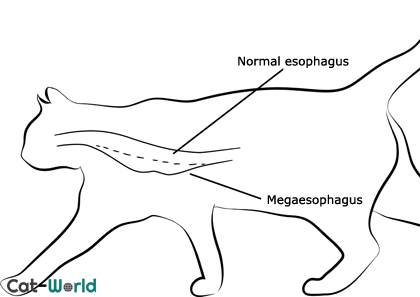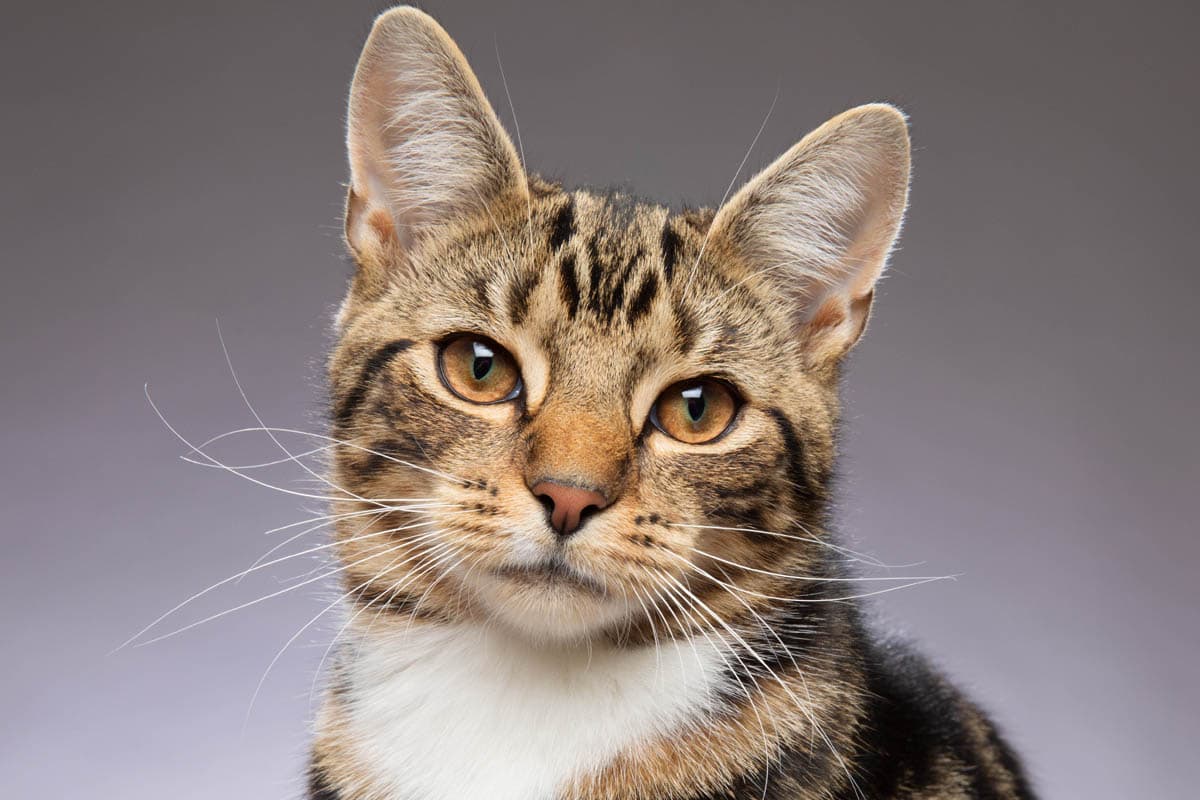What is megaesophagus?
Megaesophagus is an enlargement of the esophagus, the muscular tube that connects the throat to the stomach. Normally, when the cat eats, the esophagus senses the force of the food on the walls, which initiates the process of muscle contraction, which pushes the food down to the stomach (called peristalsis).
Megaesophagus is a multi-factorial disorder in which nerves and/or muscle dysfunction affects the ability of the esophagus to constrict and push food from the throat to the stomach. As a consequence, when the cat eats, food builds up in the esophagus, eventually causing regurgitation (passed back out).
Not only does the cat not receive adequate nutrients, but the presence of food sitting in the throat also predisposes him to aspiration pneumonia.
Megaesophagus can be mild, with only a small portion of the esophagus affected, or affect the entire esophagus.
Regurgitation vs vomiting
Regurgitated food looks the same as before it was consumed, vomited food is more sausage-like in appearance.
Regurgitation appears effortless, the cat opens his mouth and out it comes, compared to vomiting which is an active process, which will consist of gagging, retching, and the sides will heave.
Causes

The condition may be congenital, meaning present at birth, or acquired. It may be permanent or may be transient (such as with tick paralysis). There is a higher incidence of congenital megaesophagus in Siamese and related breeds.
Acquired megaesophagus may be primary or secondary and has several possible causes. Remember that the esophagus is a muscular tube, so any condition which affects the muscles can cause megaesophagus.
Vascular ring anomaly (persistent right aortic arch): A congenital disorder in which a fetal blood vessel called the right aortic arch, fails to disappear as it should post-birth. This vessel passes close to the esophagus and can cause it to become compressed, blocking the flow of food to the stomach.
Myasthenia gravis: A congenital or acquired neuromuscular disorder that causes muscle weakness. All muscles are controlled by their own nerve, this nerve doesn’t directly connect to the muscle, there is a small gap between the two which is known as the neuromuscular junction.
For a message to be transmitted from the nerve to the muscle, a chemical messenger called acetylcholine bridges the gap. It travels from the end of the nerve and attaches to the acetylcholine receptor. Cats affected by myasthenia gravis have an abnormal transmission between the two.
Glycogen storage disease: An inherited disorder affecting some Norwegian Forest cats characterised by an inability to metabolise glycogen, a stored form of sugar in the body. Glycogen builds up in the tissues including the muscles which can lead to muscle weakness.
Dysautonomia (Key-Gaskell syndrome): A rare condition characterised by an inability of the autonomic nervous system (which works without conscious control) to function properly. The esophagus is a part of the autonomic nervous system and as such, may be affected in cats with this condition.
Addison’s disease (hypoadrenocorticism): Addison’s disease is a deficiency of corticosteroids produced by the adrenal glands. This disease can cause muscle weakness in cats.
Inflammation of the esophagus: Inflammation (esophagitis) can occur due to infection, chronic vomiting, foreign body, cancer, irritation and most commonly reflux.
Thymoma: A rare tumour arising from the thymus gland in the chest.
Venoms or toxins: Botulism, tetanus, paralysis ticks and the Australian tiger snake can cause paralysis.
Esophageal obstruction: Foreign body, hiatal hernia, tumour or stricture.
Congenital or acquired idiopathic: No known cause.
Symptoms
Symptoms can vary depending on the area affected. Cats with congenital megaesophagus typically display symptoms once they wean. However, some nursing kittens may also regurgitate milk through their nose, commonly referred to as milk nose.
- Regurgitation of food
- Coughing and/or gagging
- Nasal discharge
- Stunted growth in kittens
- Weight loss
- Bad breath
- Salivation
If aspiration pneumonia occurs, your cat may experience additional symptoms including:
- Fever
- Breathing difficulty
- Lung sounds
Diagnosis
Your veterinarian will perform a physical examination and obtain a medical history from you, which will include:
- Onset of symptoms
- What the vomit looks like (digested or not)
- How soon after eating does your cat vomit
- Any underlying medical conditions?
Diagnosis is twofold, diagnose megaesophagus and the underlying cause.
Diagnostic workup:
- Baseline tests: Biochemical profile, complete blood count, and urinalysis can’t diagnose megaesophagus but may be of help in identifying an underlying cause.
- Xray of the esophagus and chest: May reveal an enlarged esophagus filled with gas, fluid or food, persistent right aortic arch, blockages, tumours and foreign body.
- Barium contrast study: A test in which barium is swallowed by the cat and then a series of x-rays are performed to visualise the esophagus. Barium is a radio-opaque, meaning that it shows up as bright white on x-rays making it easier for the veterinarian to visualise the esophagus.
- Fluoroscopy: Another test your veterinarian may choose to carry out to evaluate the esophagus. This test uses x-rays in real-time to evaluate the esophagus.
- Esophagoscopy: A procedure in which an endoscope, a flexible, thin plastic tube with a lens at one end and a video camera at the other, is inserted into the mouth and used to examine the interior of the esophagus as well as look for blockages, lesions, inflammation, tumours and foreign objects.
- Blood tests: To look for antibodies directed towards the acetylcholine receptor in cats suspected of having Myasthenia gravis.
-
ACTH stimulation test: A test to measure the ability of the adrenal glands to respond to the adrenocorticotropic hormone (ACTH). This hormone is made in the pituitary gland and travels through the bloodstream to the adrenal glands where it stimulates the secretion of other hormones such as hydrocortisone from the cortex. The ACTH stimulation test measures levels of cortisol in the blood before and after an injection of synthetic ACTH.
Treatment
The goal of treatment is to address the underlying cause and provide supportive care.
For cats with megaesophagus which can’t be reversed by treatment, the aim is to prevent aspiration pneumonia and ensure adequate nutrition. This may include:
- Elevated feeding position: Feeding cats in an upright position to help gravity move down the esophagus. The recommended angle is 45-90 degrees from the floor and the cat should remain in that position for 10-15 minutes after eating. Some suggestions include placing the bowl on a table that is too small for your cat to sit on so he has to eat standing up, holding your cat in an upward position while you or somebody else feeds him, I have even seen one cat held upright in a sling.
- Dogs with megaesophagus can be fed in a bailey chair, I am not sure how amenable a cat would be to such a device.
- High-calorie diet: In liquid slurry which is easier to travel down the esophagus.
- Frequent meals: Feeding smaller but more frequent meals 3-4 times a day.
- Medications: Metoclopramide or Cisapride which can help to increase motility of the esophagus.
- Supportive care: Additional antibiotics and supportive care such as oxygen therapy will be necessary to treat cats with aspiration pneumonia.
Prognosis
This depends on the underlying cause. The outcome is positive in cats with acquired megaesophagus. For cats with idiopathic or congenital megaesophagus, the prognosis is poor.

